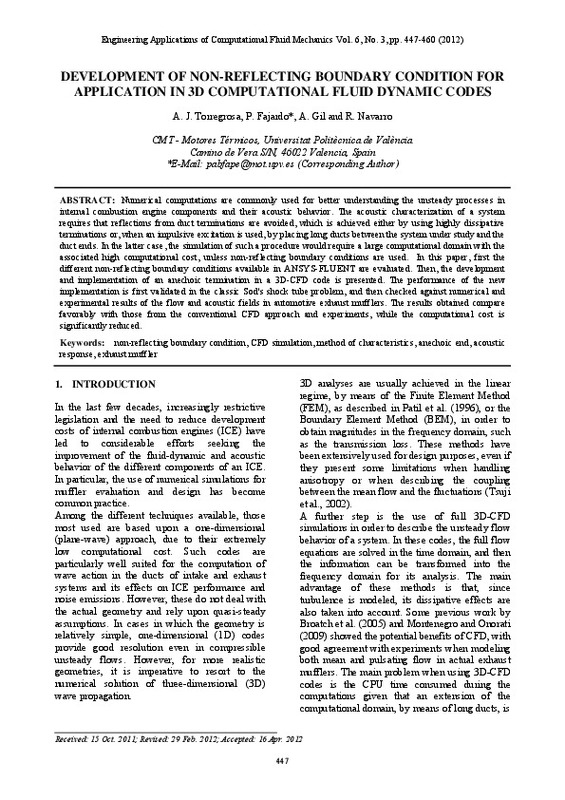JavaScript is disabled for your browser. Some features of this site may not work without it.
Buscar en RiuNet
Listar
Mi cuenta
Estadísticas
Ayuda RiuNet
Admin. UPV
Development of non-reflecting boundary condition for application in 3D computational fluid dynamics codes
Mostrar el registro sencillo del ítem
Ficheros en el ítem
| dc.contributor.author | Torregrosa, A. J.
|
es_ES |
| dc.contributor.author | Fajardo, Pablo
|
es_ES |
| dc.contributor.author | Gil Megías, Antonio
|
es_ES |
| dc.contributor.author | Navarro García, Roberto
|
es_ES |
| dc.date.accessioned | 2016-11-30T17:16:45Z | |
| dc.date.available | 2016-11-30T17:16:45Z | |
| dc.date.issued | 2012-09 | |
| dc.identifier.issn | 1994-2060 | |
| dc.identifier.uri | http://hdl.handle.net/10251/74820 | |
| dc.description | This is an Author's Accepted Manuscript of an article published in [include the complete citation information for the final version of the article as published in the Engineering applications of computational fluid mechanics, 2012 © Taylor & Francis, available online at: http://doi.org/ 10.1080/19942060.2012.11015434 | |
| dc.description.abstract | [EN] Numerical computations are commonly used for better understanding the unsteady processes in internal combustion engine components and their acoustic behavior. The acoustic characterization of a system requires that reflections from duct terminations are avoided, which is achieved either by using highly dissipative terminations or, when an impulsive excitation is used, by placing long ducts between the system under study and the duct ends. In the latter case, the simulation of such a procedure would require a large computational domain with the associated high computational cost, unless non-reflecting boundary conditions are used. In this paper, first the different non-reflecting boundary conditions available in ANSYS-FLUENT are evaluated. Then, the development and implementation of an anechoic termination in a 3D-CFD code is presented. The performance of the new implementation is first validated in the classic Sod's shock tube problem, and then checked against numerical and experimental results of the flow and acoustic fields in automotive exhaust mufflers. The results obtained compare favorably with those from the conventional CFD approach and experiments, while the computational cost is significantly reduced. | es_ES |
| dc.description.sponsorship | This work has been partially supported by Ministerio de Ciencia e Innovacion through grant No. DPI2009-14290. The authors wish to thank Dr. David R. Perry for his kind assistance in manuscript editing. | |
| dc.language | Inglés | es_ES |
| dc.publisher | Taylor & Francis Group | es_ES |
| dc.relation.ispartof | Engineering Applications of Computational Fluid Mechanics | es_ES |
| dc.rights | Reserva de todos los derechos | es_ES |
| dc.subject | Non-reflecting boundary condition | es_ES |
| dc.subject | CFD simulation | es_ES |
| dc.subject | Method of characteristics | es_ES |
| dc.subject | Anechoic end | es_ES |
| dc.subject | Acoustic response | es_ES |
| dc.subject | Exhaust muffler | es_ES |
| dc.subject.classification | INGENIERIA AEROESPACIAL | es_ES |
| dc.subject.classification | MAQUINAS Y MOTORES TERMICOS | es_ES |
| dc.title | Development of non-reflecting boundary condition for application in 3D computational fluid dynamics codes | es_ES |
| dc.type | Artículo | es_ES |
| dc.identifier.doi | 10.1080/19942060.2012.11015434 | |
| dc.relation.projectID | info:eu-repo/grantAgreement/MICINN//DPI2009-14290/ES/Herramientas Experimentales Y Computacionales Para El Silenciamiento De Plantas De Potencia Basadas En Turbinas De Gas/ | es_ES |
| dc.rights.accessRights | Abierto | es_ES |
| dc.contributor.affiliation | Universitat Politècnica de València. Instituto Universitario CMT-Motores Térmicos - Institut Universitari CMT-Motors Tèrmics | es_ES |
| dc.contributor.affiliation | Universitat Politècnica de València. Escuela Técnica Superior de Ingeniería del Diseño - Escola Tècnica Superior d'Enginyeria del Disseny | es_ES |
| dc.description.bibliographicCitation | Torregrosa, AJ.; Fajardo, P.; Gil Megías, A.; Navarro García, R. (2012). Development of non-reflecting boundary condition for application in 3D computational fluid dynamics codes. Engineering Applications of Computational Fluid Mechanics. 6(3):447-460. https://doi.org/10.1080/19942060.2012.11015434 | es_ES |
| dc.description.accrualMethod | S | es_ES |
| dc.relation.publisherversion | http://dx.doi.org/10.1080/19942060.2012.11015434 | es_ES |
| dc.description.upvformatpinicio | 447 | es_ES |
| dc.description.upvformatpfin | 460 | es_ES |
| dc.type.version | info:eu-repo/semantics/publishedVersion | es_ES |
| dc.description.volume | 6 | es_ES |
| dc.description.issue | 3 | es_ES |
| dc.relation.senia | 226524 | es_ES |
| dc.contributor.funder | Ministerio de Ciencia e Innovación | |
| dc.description.references | ANSYS Inc. (2009). Ansys Fluent 12.0 User’s Guide. Canonsburg, PA: ANSYS Inc. | es_ES |
| dc.description.references | Benson RS (1982).The Thermodynamics and Gas Dynamics of Internal Combustion Engines. Volume 1, Oxford: Oxford University Press. | es_ES |
| dc.description.references | Luján JM, Bermúdez V, Serrano JR, Cervelló C (2002). Test bench for turbocharger groups characterization.SAE Paper2002–01-0163. | es_ES |
| dc.description.references | Munjal ML (1987).Acoustics of Ducts and Mufflers. New York: Willey. | es_ES |
| dc.description.references | Onorati A, Montenegro G, D’Errico G (2006). Prediction of the attenuation characteristics of IC engine silencers by 1-D and multi-D simulation models.SAE Paper2006–01-1541. | es_ES |
| dc.description.references | Patil AR, Sajanpawar PR, Masurekar VV (1996) Acoustic three dimensional finite element analysis of a muffler.SAE Paper960189. | es_ES |








